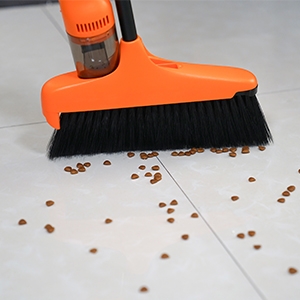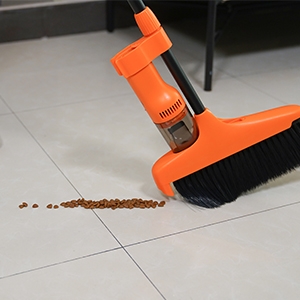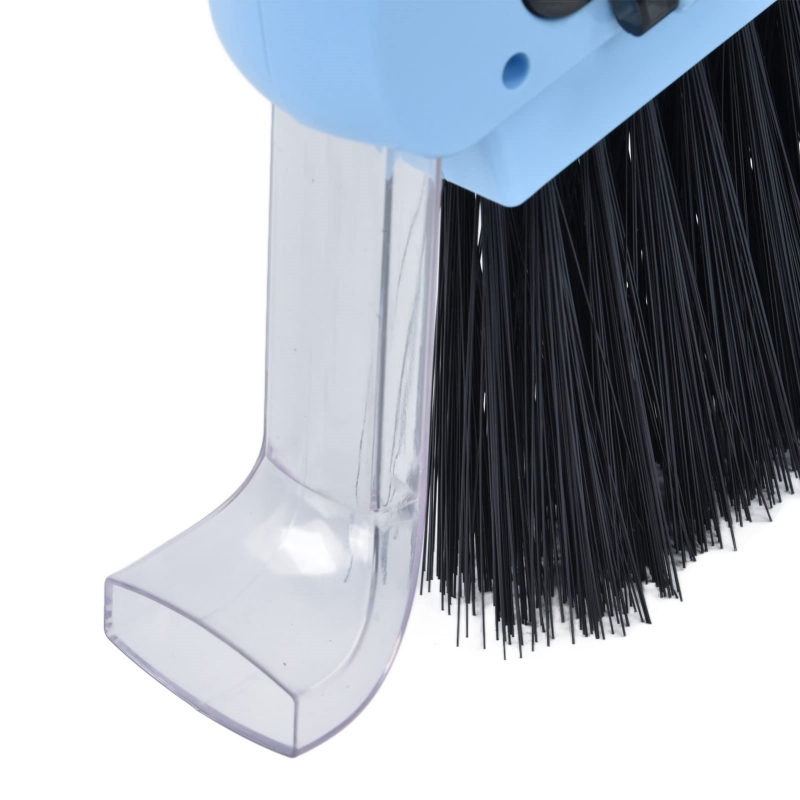
Essential Attachments for Your Broom Vacuum: A Buyer’s Guide
One great way to expand the functionality of your broom vacuum is by utilizing useful attachments and accessories. The right attachments allow you to clean

In today’s fast-paced world, cordless broom vacuums have emerged as a household essential, offering unparalleled convenience and mobility.
However, one common concern among users is the longevity of the battery life. A vacuum that runs out of charge mid-cleaning can be a significant hindrance, disrupting the flow of chores and leaving tasks unfinished.
Maximizing the battery life of your cordless broom vacuum not only ensures a seamless cleaning experience but also extends the overall lifespan of the device.
Whether you’re a new user or someone looking to optimize your current vacuum’s performance, understanding how to make the most of its battery life can be a game-changer.
In this guide, we’ll delve into practical tips and strategies to help you get the most out of your cordless broom vacuum’s battery, ensuring efficient cleaning sessions every time.

Understanding lithium-ion batteries used in cordless broom vacuums is the first step. Here’s an overview:
During recharging, current flows into the battery which drives lithium ions from the cathode to the anode. This stores energy for later vacuum use.
When powering the vacuum, current flows in the other direction. Ions move back from the anode to the cathode releasing stored energy to run the motor.
A battery management system monitors voltage, current, temperature, etc. to maximize performance and life. Smart cordless vacuums have advanced battery management.
Understanding these basics helps explain how different usage factors affect lithium-ion battery lifespan and runtime.
Follow these tips to get the most cleaning time from each charge and enhance the overall battery lifespan:
Fully draining batteries from max charge down to empty shortens their lifespan. Try to recharge at 20-30% capacity remaining.
Heat degrades batteries faster. Don’t leave batteries charging for days unattended or store vacuums in hot places.
Only use the cordless vacuum’s included charger. Other chargers can overcharge batteries, shortening their life.
Don’t leave discharged batteries sitting for days or weeks before recharging. Recharge them within 12 hours after vacuum use.
Run batteries down fully then recharge to 100% about once per month. This helps calibrate battery percentage displays.
For vacuums supporting hot-swappable batteries, swap in a freshly charged pack when the current battery hits 20-30% rather than fully draining it.
Using vacuums in very warm environments can shorten battery life. Clean when indoor temperatures are moderate.
Replace aging batteries that hold significantly fewer charges. Lithium-ion batteries last around 500 charge cycles before needing replacement.
Replace dead batteries with identical cells from the vacuum maker. Third-party cells often don’t integrate optimally.
Download the latest firmware updates for your model. These sometimes improve battery management and charging efficiency.
Following these battery care best practices will help you get the cleanest runtime from each charge and enhance longevity. Next, we’ll cover usage habits to avoid.
Certain usage patterns can dramatically shorten runtime per charge. Be aware of these battery-draining habits:
Only use max suction when needed. Use lower power settings for lighter cleaning to conserve battery life.
Soft roller heads conserve more battery power. Use stiffer brushes only when cleaning carpets or heavy debris.
Dirty filters block airflow requiring more power draw to sustain suction, draining batteries faster.
An overpacked dust bin restricts airflow much like a dirty filter, demanding more battery usage.
Hair and debris caught in the brush roll bearings increase drag and power consumption.
Draining the battery to automatic shutdown on each use strains the battery, reducing lifespan.
Adjusting these habits will help your batteries last longer per charge. Next, we’ll go over tips for storing cordless vacuums to protect battery health.

Storing cordless broom vacuums properly between uses preserves battery capacity. Follow these storage guidelines:
Fully charging or fully draining batteries during storage accelerates capacity loss. 40-50% is ideal.
If possible, remove stick vacuum batteries rather than leaving them in the vacant unit during storage.
Don’t store batteries or vacuums long-term in excessively hot or cold environments. 10-25°C (50-77°F) is best.
If storing vacuums long term, keep them in a climate-controlled space. Avoid attics, garages and sheds.
Newer vacuums may offer a hibernation mode to protect batteries when storing the vacuum.
Recharge stored batteries back to 40-50% every 3 months minimum to 6 months max for optimal health.
Proper storage minimizes battery self-discharge and capacity loss when they’re not powering the vacuum.
Watch for these signs that your cordless vacuum’s batteries need replacement:
Contact the manufacturer about possible battery replacements if you notice these issues.
You can stretch cordless cleaning time further by being strategic while vacuuming:
Work room-by-room rather than randomly moving all over to cut down on battery use traversing your home.
Lower power heads for bare floors and raise them for carpets rather than continually tweaking height while cleaning mixed surfaces.
Plug into centrally located outlets while cleaning different rooms to minimize battery drain walking back to the charger.
Only utilize max suction if essential for heavy debris cleaning. The lowest effective setting preserves batteries.
Don’t wait for dust bins to reach total capacity. Empty them when partially full to maintain airflow and minimize power demands.
Following these vacant practices further optimizes battery usage during cleaning.
Not all cordless vacuums are equal when it comes to squeezing maximum runtime out of each charge. Here are some battery life benchmarks by brand:
Top-rated Dyson stick vacuums like the V15 Detect provide a 60-minute fade-free runtime on maximum mode. Excellent battery management provides consistent cleaning time.
Up to 80 minutes of cleaning time per charge is standard for Shark cordless stick vacuums like the Vertex with Anti Hair Wrap. Removable batteries enable unlimited runtime.
Most Bissell cordless broom vacs average around 30-45 minutes of runtime. Lower voltage lithium-ion cells mean more frequent charging is needed.
Newer Hoover cordless vacuums achieve 50-60 minutes per charge. Advanced Energy Blade batteries efficiently power the OnePwr vacuums.
The LG CordZero stick vacuums offer up to 80 minutes max runtime. LG’s patented Smart Inverter motor maximizes battery efficiency.
As you can see, runtime can vary widely. Prioritize vacuums from brands offering 60 minutes or longer of continuous cleaning power.

In the realm of home cleaning, cordless broom vacuums have revolutionized the way we approach our daily chores, offering unmatched flexibility and ease.
Yet, the efficacy of these devices hinges significantly on their battery performance. As we’ve explored, maximizing battery life isn’t just about prolonging cleaning sessions but also about ensuring the longevity and durability of the vacuum itself.
By adopting the strategies and tips discussed, users can optimize their device’s performance, reduce frequent replacements, and enjoy a more sustainable and efficient cleaning experience. It’s essential to remember that, like any other electronic device, a cordless broom vacuum requires mindful usage and regular maintenance.
By being proactive and informed, you can ensure that your vacuum remains a reliable companion in your cleaning endeavors for years to come.
In conclusion, while technology continues to advance, our role in using it responsibly and efficiently remains paramount. Embrace these battery-maximizing tips, and let your cordless broom vacuum truly shine in its role, making home maintenance a breeze.


One great way to expand the functionality of your broom vacuum is by utilizing useful attachments and accessories. The right attachments allow you to clean

The broom vacuum, a staple in modern households, has transformed the way we approach cleaning, offering a blend of convenience and efficiency. However, like all

The world of broom vacuums has seen a plethora of innovations, but one debate that remains at the forefront is the choice between bagged and

Broom vacuums, also commonly known as stick vacuums, are a popular choice for convenient whole-home cleaning. With their lightweight designs and versatile capabilities, broom vacuums

One great way to expand the functionality of your broom vacuum is by utilizing useful attachments and accessories. The right attachments allow you to clean

The broom vacuum, a staple in modern households, has transformed the way we approach cleaning, offering a blend of convenience and efficiency. However, like all

The world of broom vacuums has seen a plethora of innovations, but one debate that remains at the forefront is the choice between bagged and

In today’s fast-paced world, cordless broom vacuums have emerged as a household essential, offering unparalleled convenience and mobility. However, one common concern among users is
Copyright © 2024 vacbroomvacuum. All Rights Reserved.